It’s asparagus season in France. It started in Lyon a few weeks ago, and it will last a few weeks more.
I love asparagus: it’s my favorite vegetable, although parsnips and broccolini are close behind (and I’m going to count avocados as a fruit).
I grew up mostly on the macrobiotic diet, from age 7 to 18, not by choice but because my mom decided that it was the healthiest option. Macrobiotics is based on the Japanese traditional diet of 150 years ago, brought to America and advertised as the ultimate form protection against nuclear fallout, cancer, and all other illnesses. The diet is very restrictive: the ideal is that 80% of your daily calories should come from plain, cooked brown rice. The remaining 20% should be beans (especially adzuki beans), traditional soy products (miso, tofu, tamari), seaweeds, soba noodles, and the vegetables that people had access to 150 years ago in Japan: daikon, carrots, squash, onions, lotus root, burdock root, napa cabbage, and a few others. All the other vegetables, all the best ones (asparagus, peppers, eggplant, tomatoes, sweet potatoes, broccoli, peas, and so much more) were declared as “too yin” and off limits. Also off limits: all fruits except apples, all meat, all dairy, eggs and fish, all forms of sweetener except brown rice syrup, bread, and of course any and all food that comes from a grocery store rather than a 1970s style food coop. We did not eat at restaurants: if a restaurant meal was unavoidable while traveling, we were allowed to order plain oatmeal, plain rice (but we loved the fact that it was white rice), or plain boiled vegetables.
I should write a post about my experience with macrobiotics another time, but the point of this brief history is that when I first tried asparagus, in my mid-twenties, I was angry about the fact that I had never had it before: I felt like something special and delicious had been kept secret from me. After I met Christian and started spending much more time in France, I was thrilled to discover that the French love asparagus as much as I do. And they eat it like it’s going out of style during its short, spring season.
Starting in late March, asparagus is suddenly on the menu in almost every restaurant. Small restaurants in France change their daily special (the plat or menu du jour) daily and with the seasons. Overflowing crates of asparagus appear at the markets and in grocery stores, and people take advantage of its peak freshness, wide availability, and accessible price.
If you want the early asparagus, the first week that it appears at your local market, you will definitely pay more and will have to fight for your place in line.
In France, asparagus comes in three colors: green, purple, and white. The green variety is the same as ours except that the spears tend to be thicker, the way the French prefer them. For most of my life I thought that I liked thin spears better, but that was because thicker spears are often woody and tough in the US – that is not at all the case in France.
Purple asparagus is a dark violet in color, like a purple cabbage, and it surprisingly turns green when cooked. The purple color comes from a natural genetic mutation (it has twice as many chromosomes) and it has the same healthy anthocyanin antioxidants as other dark colored vegetables. Its price point in France is in the middle: it costs more than green asparagus, but not nearly as much as white.
White asparagus is at the top of the asparagus hierarchy in France. It is the most sought after, the most popular, and widely regarded as the best variety. I don’t think that Christian had ever purchased or cooked green asparagus at home before I started doing it. He still prefers white, but now he allows that green is acceptable when you can’t find good quality white at a reasonable price. The price in the market photo above, taken at the peak of the season, is on the low end and converts to $4.20 per pound. At the beginning of the season or in grocery stores it costs more than double that price.
White asparagus is more expensive because it takes more work to produce. Asparagus is a perennial plant: it takes two to three years after planting to have asparagus that you can harvest, but once the bed is established the shoots should come up every spring for 15 to 30 years.
The shoots are harvested as they emerge from the ground in the spring, cut off at ground level. The plants will send up shoots for three to eight weeks, depending on the health and maturity of the asparagus bed. When the growth slows down and the shoots become small (smaller than the diameter of a pencil), the plants are allowed to grow through the summer, taking in nutrients that are needed for the following year’s growth.
The key to growing white asparagus is to keep the shoots covered in soil as they are growing: this prevents sunlight from reaching the plants, which in turn inhibits the formation of chlorophyll, the photosynthesis molecule that makes plants green. Years ago, I took a plant physiology class at my university from my friend Steve, and I remember learning that this phenomenon is called etiolation: when plants do not have enough light, they develop long, pale stems (ideal for asparagus) and smaller leaves. This works well for asparagus because as a perennial plant, it is getting nutrients from the deep root bed. The French also use this etiolation technique for endive: that’s why endive is mostly white, with pale yellow leaves. At markets and in grocery stores, the endive almost always has a cardboard cover over it: even the fluorescent lighting in a supermarket can provoke some unwanted chlorophyll formation.
White asparagus can be produced from either the green or purple varieties. The difficulty of keeping the shoots covered in soil is the fact that they grow every day, anywhere from two to six inches. Soil has be mounded around the growing shoots every day to keep them covered; some producers also cover the entire bed in black plastic during the day, after harvesting in the early morning. These added labor costs are what make white asparagus more expensive.
Having loved green asparagus for a long time, I was skeptical about the white variety. Coming from the US, I was biased toward thinner stems; most white asparagus is decidedly thick. Also, its outer skin is very tough and it has to be peeled, at least three quarters of the way up the stem – this too I took as a sign that it would not be as good as the green version. Finally, I was also skeptical about Christian’s insistence on boiling it: my preferred way to cook the green variety is to sauté it with a little olive oil in a cast iron pan.
Of course I should have known better: the French are perhaps the world’s biggest food connoisseurs, and they know what they’re doing when it comes to choosing the best variety of almost everything.
Boiling made the peeled spears tender while leaving unpeeled tips also perfectly cooked. The best way I can describe the difference in flavor is that the white asparagus has a flavor is subtly deeper and more profound, and that develops as you chew it. At first it seems less flavorful, almost bland, but in your mouth it quickly becomes something else: minerally, bittersweet, and not like anything else I’ve tasted. I’m convinced that this is one reason that it’s so popular in France, where people like nothing better than a taste that is out of the ordinary.
In Lyon, we have a special rectangular plate that is used for serving asparagus. A clean cloth napkin is placed on the plate, and the asparagus spears are lifted out of the simmering water with a slotted spoon, all lined up in the same direction on the plate. The napkin is folded to cover them, keeping them warm.
The most common way to eat asparagus in France is with mayonnaise. We buy store bought mayonnaise for most of the year (Amora, in glass jars), but during asparagus season we make fresh mayonnaise every time we eat it, which on the average is three times per week. The season is short, and as the French say, “il faut profiter” – it’s time to take advantage. I should also note that asparagus is NOT available year round in French grocery stores like it is in the US. Once the season is over, you have to wait until next year.
Christian made the mayonnaise for the first two years that we enjoyed asparagus season together. He made it by hand, with a whisk, though I did manage eventually to convince him that the hand mixer I bought was a better option. The mayonnaise is better if it sits in the fridge for an hour or two before you eat, so I decided to try making it myself so we could eat dinner earlier – wanting to eat an early dinner is one of the Minnesotan things that has firmly remained entrenched for me despite all the time I spend in France.
In French, you must monter your mayonnaise, which means to lift or raise it. Ideally, your whipping action will result in a kind of alchemy between the egg yolk and the oil that transforms it from a liquid to a pillowy solid, much like what happens when you whip cream. But if you are not careful, your mayonnaise will fall (tomber), either remaining or returning to a liquid, and you will have failed it (rater).
I failed my first two attempts. Here is my fallen mayonnaise with green asparagus that I bought and cooked:
I was shocked when Christian suggested that perhaps my mayonnaise had fallen because I was having my period: apparently this is a very prevalent French superstition, so much so that as recently as 2024, a daily newspaper published an interview with a French (female) gynecologist who was quoted as saying, “There is no possible physiological correlation between making mayonnaise – or even cooking at all – and the menstrual period.”[1] See my post about air conditioning in France for more strange French superstitions.
To his credit, Christian accepted that the idea was absurd as soon as I pointed it out. But period or not, I was still failing my mayonnaise, so I went straight to the source: my mother-in-law. I guess that means that this recipe officially comes from a French grandmother. She was happy to show me her technique (also with a hand-mixer) and since then I have not failed.
First, all the ingredients should be at room temperature. The egg, especially, must be very fresh at and at room temperature. This is much less of an issue in France than it is in the US. In France, all eggs are stamped with a code that indicates whether they are organic and/or free range and the date that they were packaged. Freshly laid eggs (that are not washed) do not need refrigeration and will keep at room temperature for several weeks. One of the things that shocks Americans are that eggs are on regular shelves in French grocery stores, not in refrigerated cases. After purchase, they stay on the counter. We only put them in the refrigerator if we are going to be leaving for a week or longer, or sometimes in July and August when it is very hot in the apartment.
If I were going to make mayonnaise in the US, I would only do it with fresh, local eggs from someone I know. I should put in a disclaimer here stating that I am not encouraging the consumption of raw eggs. Pasteurized eggs are available: these are what restaurants use to make homemade mayonnaise.
Crack your room temperature egg and separate the yolk (which goes into the bowl you will be using) from the white: you can keep the whites in a jar and make coconut macarons or meringues once you have four of them. Add almost a tablespoon of Room temperature Dijon mustard to the bowl: when I had my lesson we were making a double batch, but you can see the right proportions from the photo.
Then add a pinch of salt and a teaspoon of vinegar - balsamic, red wine, white wine, it really doesn’t make much difference. Some people use lemon juice, but I find that my mayonnaise is more fragile with lemon juice than with vinegar.
Start your mixer, but don’t use it on the highest speed: you want level two. Remember that mayonnaise is traditionally hand whisked. Mix what is already in the bowl (egg yolk, mustard, salt, vinegar), then very slowly being adding a file (wire) of oil while mixing. In the beginning you can stop adding the oil and mix, then restart, but by the middle you should be adding oil in a a very thin, fine, and consistent stream. The oil should always land in the same place in the bowl, and your beaters (which are not directly under the stream) should also not change place or direction. A steady hand is probably the most important requirement.
I like to use half olive oil and half something else - sunflower, walnut, canola, whatever you like. There is no set amount I can give you for a recipe: keep adding oil until your mayonnaise has the consistency of mayonnaise.
Here is my first successful mayonnaise:
In Minnesota, asparagus season has not yet started. Here is a photo from April 3rd:
The last of the snow melted about two weeks ago. The first asparagus should appear around mid-May, but around here those lucky enough to have their own crop will likely be eating it themselves. Meanwhile, I keep getting tantalizing photos from Christian…
For those of you lucky enough to live where asparagus is already in season, bon appétit!
[1] https://www.20minutes.fr/actu-generale/4093204-20240528-non-rate-mayonnaise-quand-regles



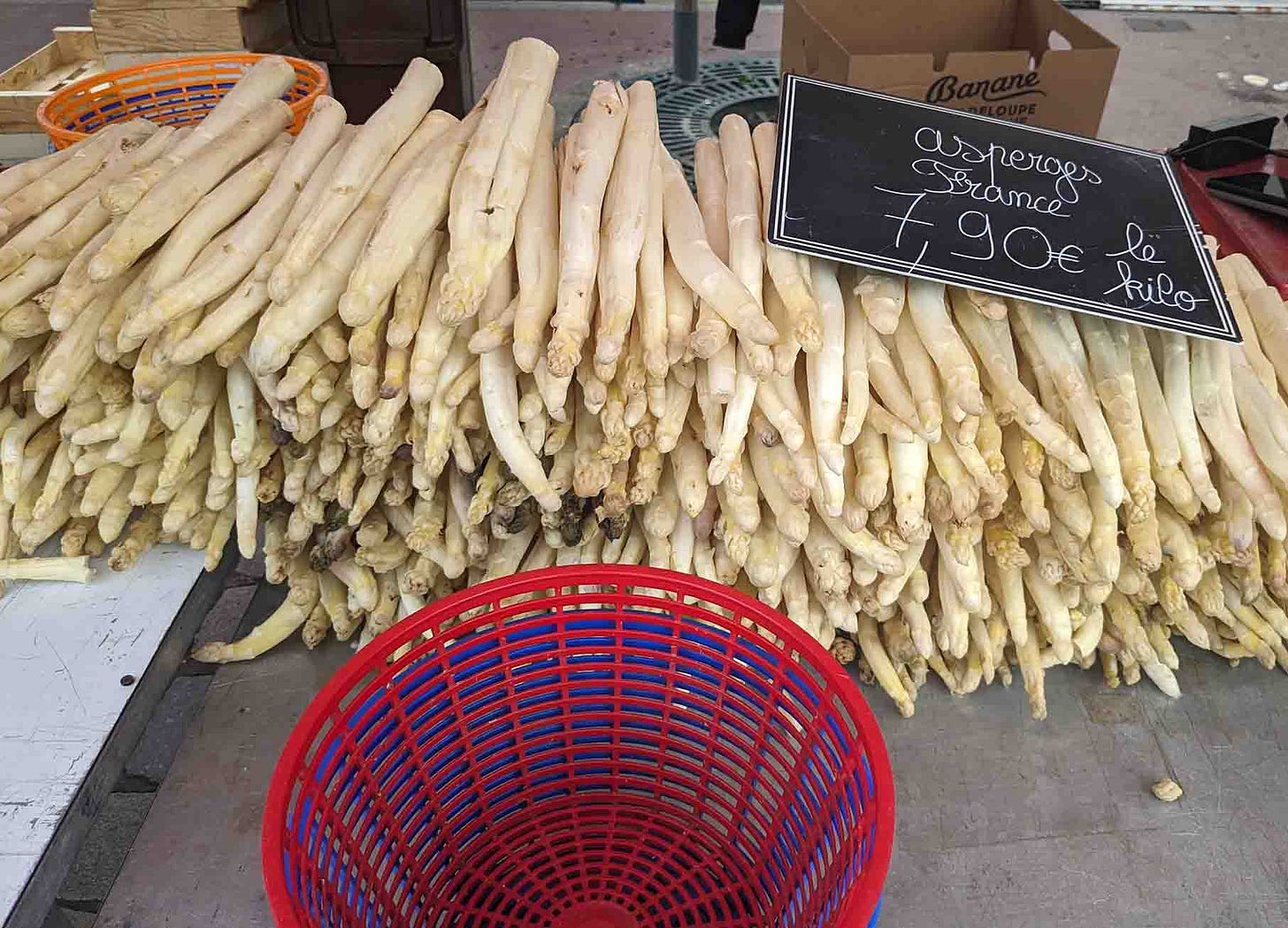
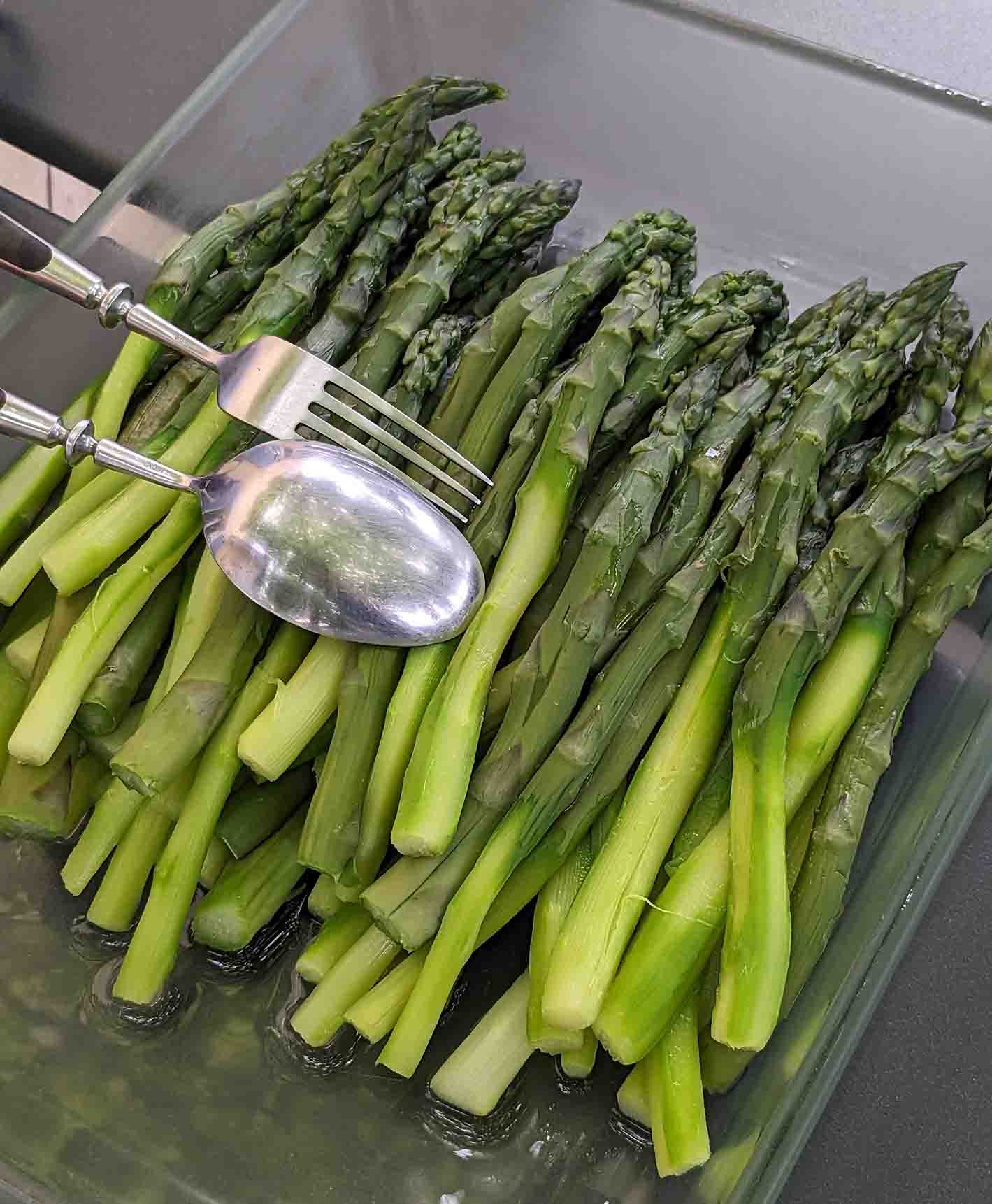
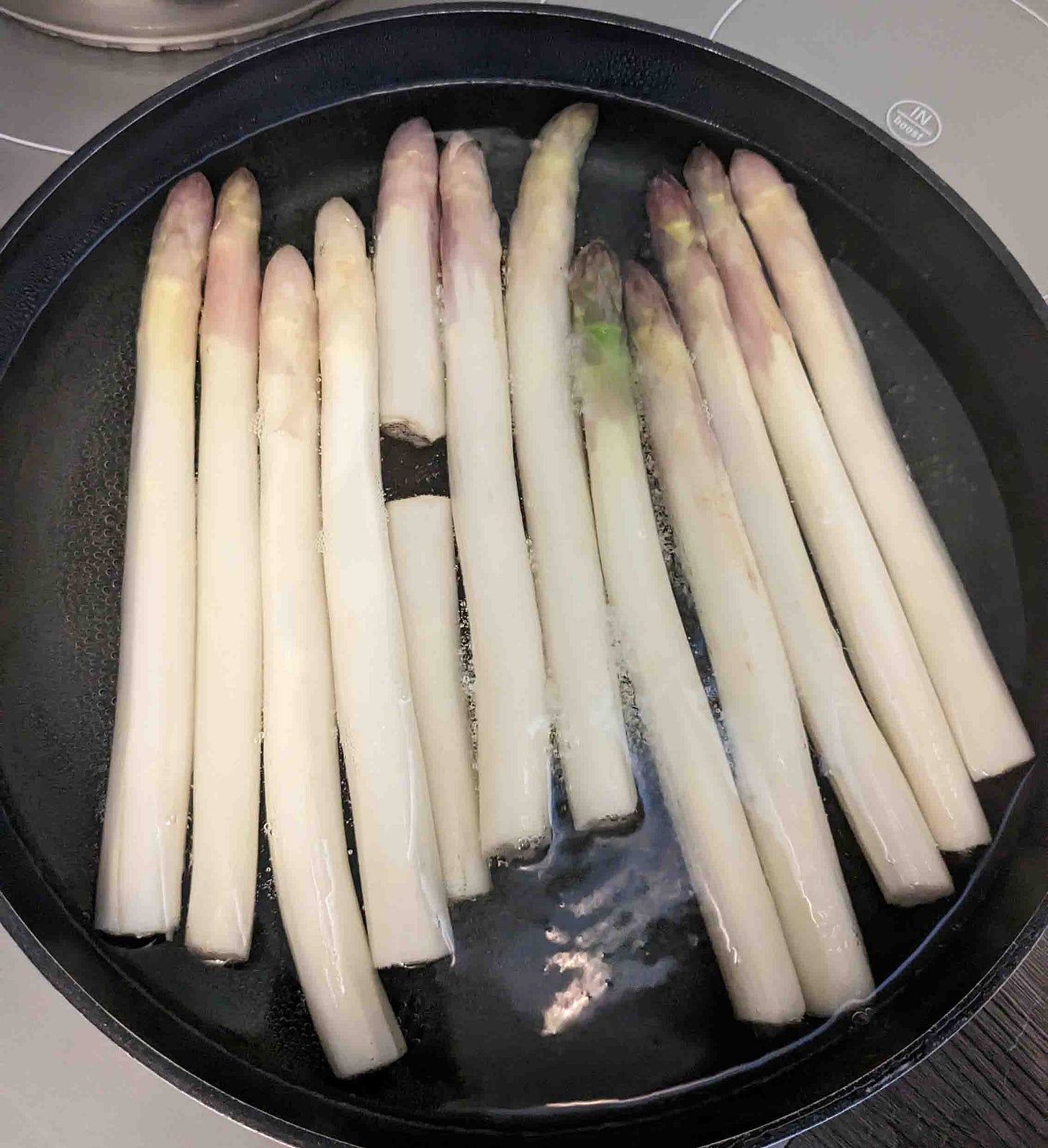
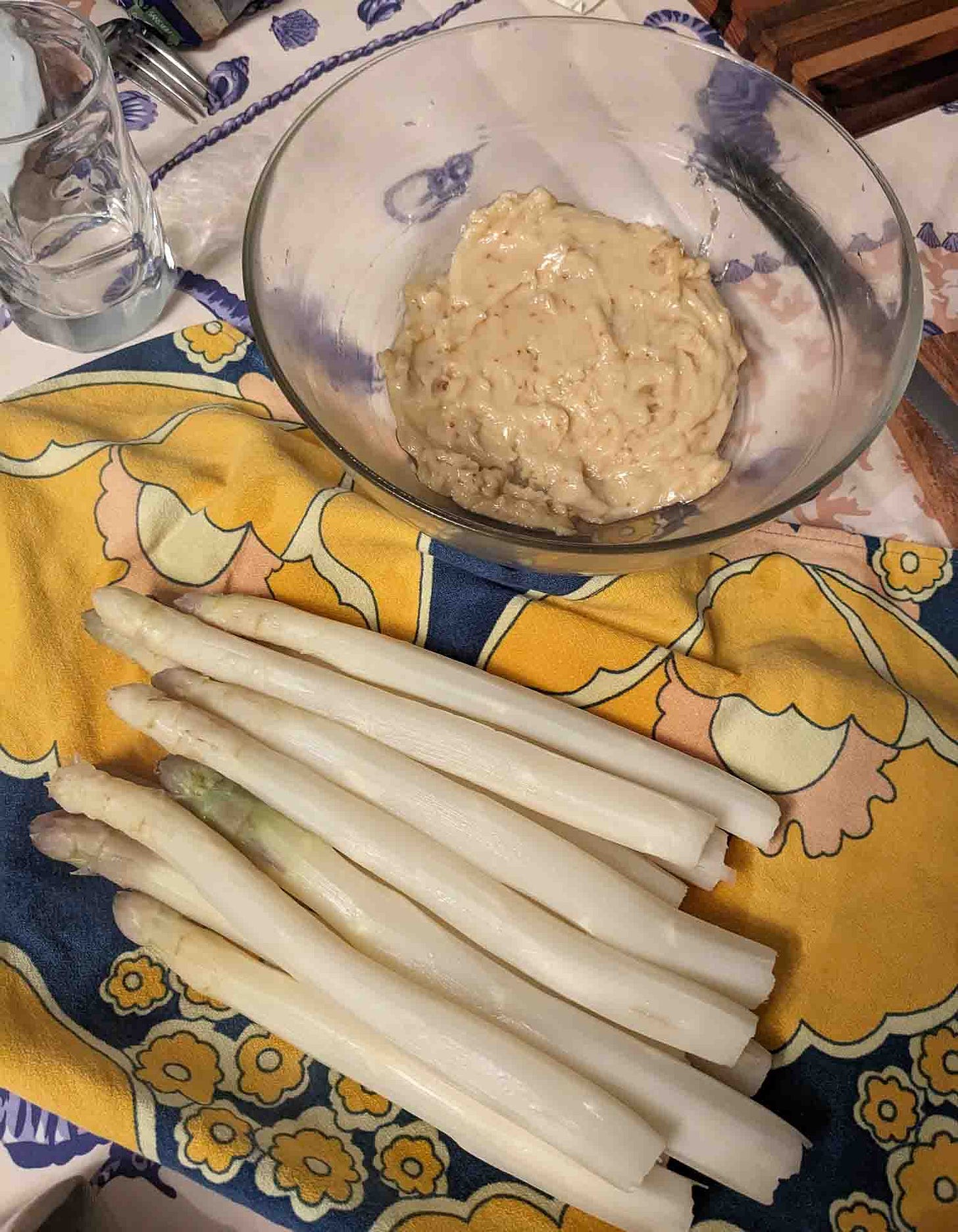
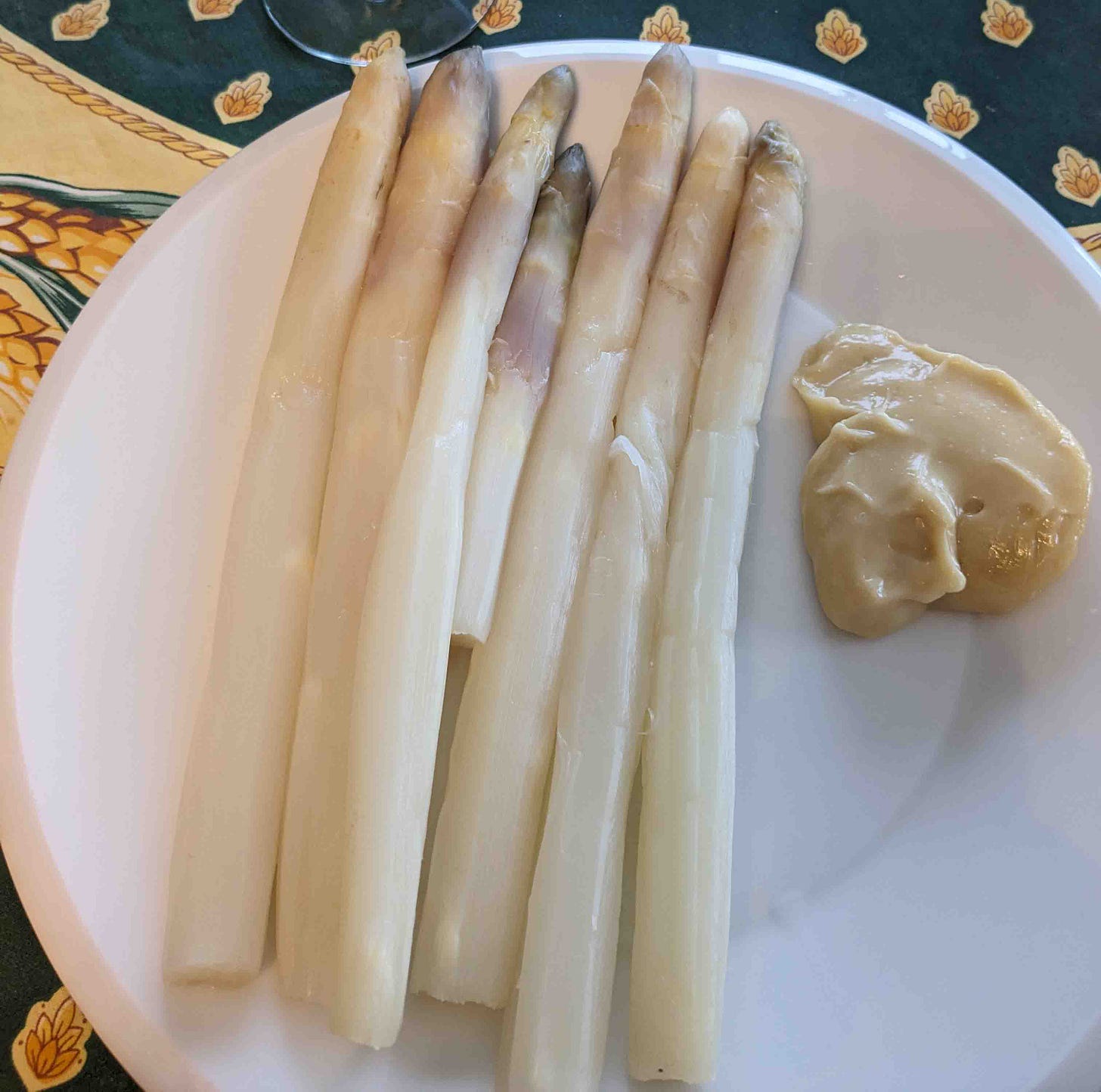

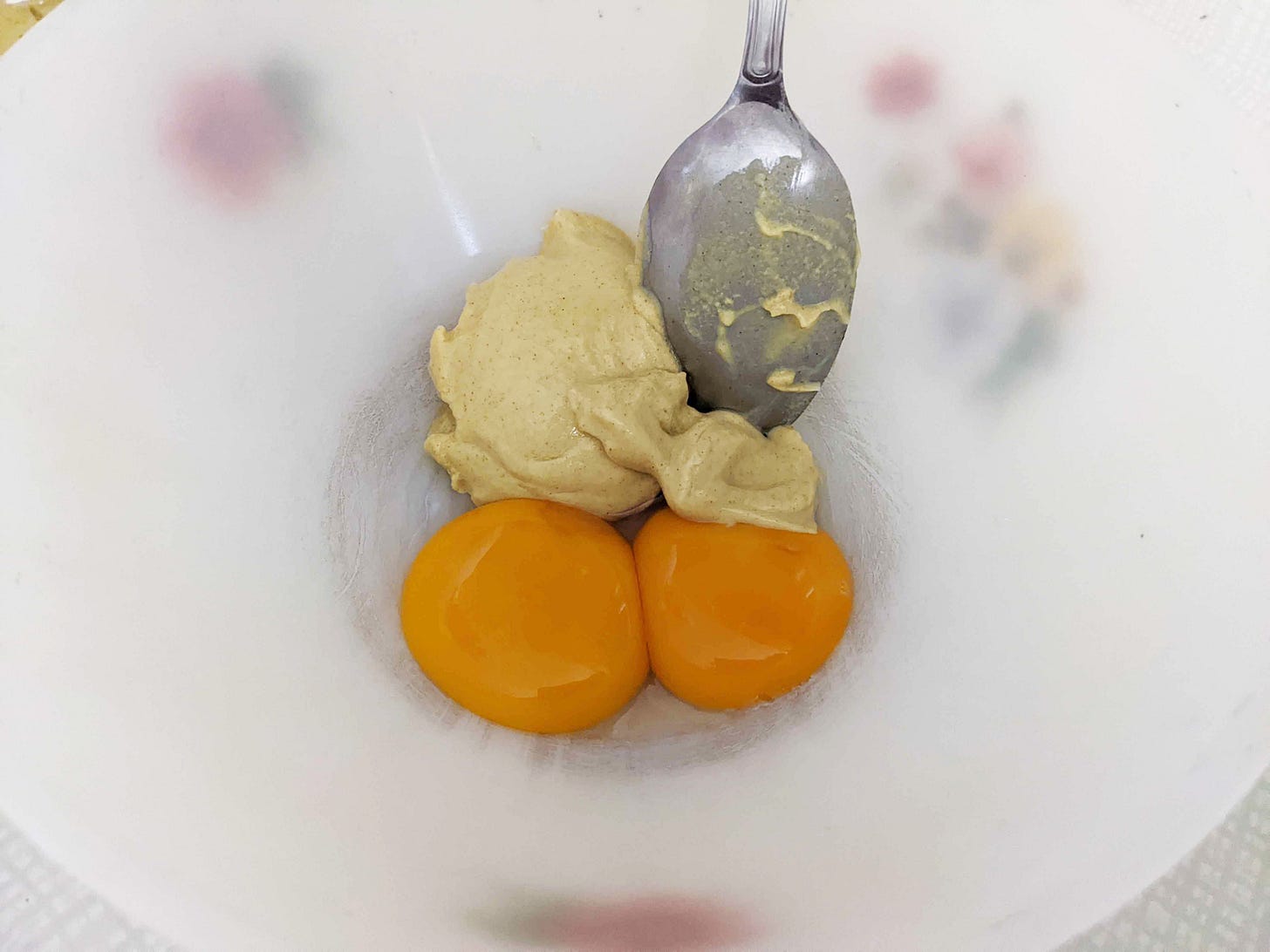
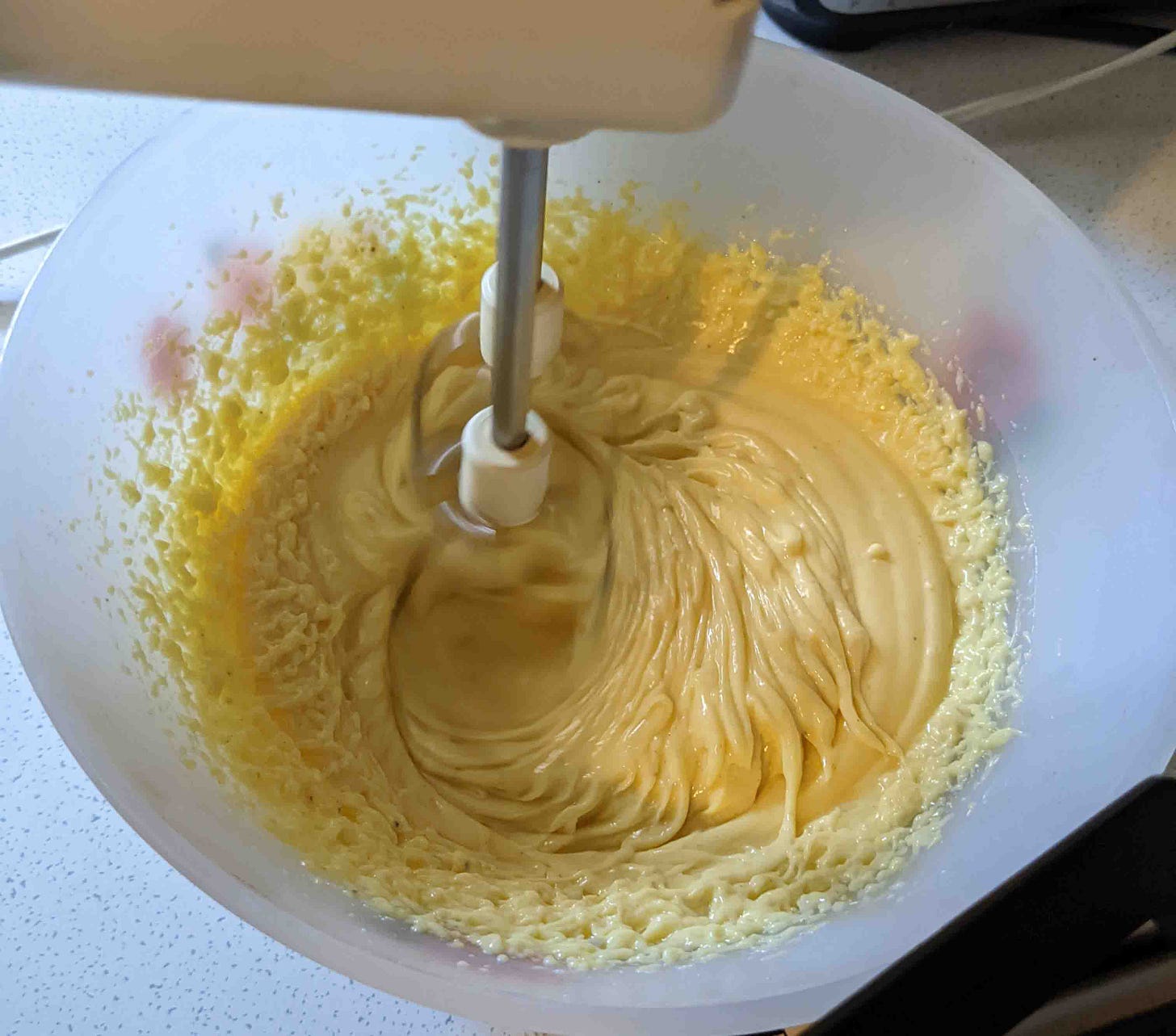
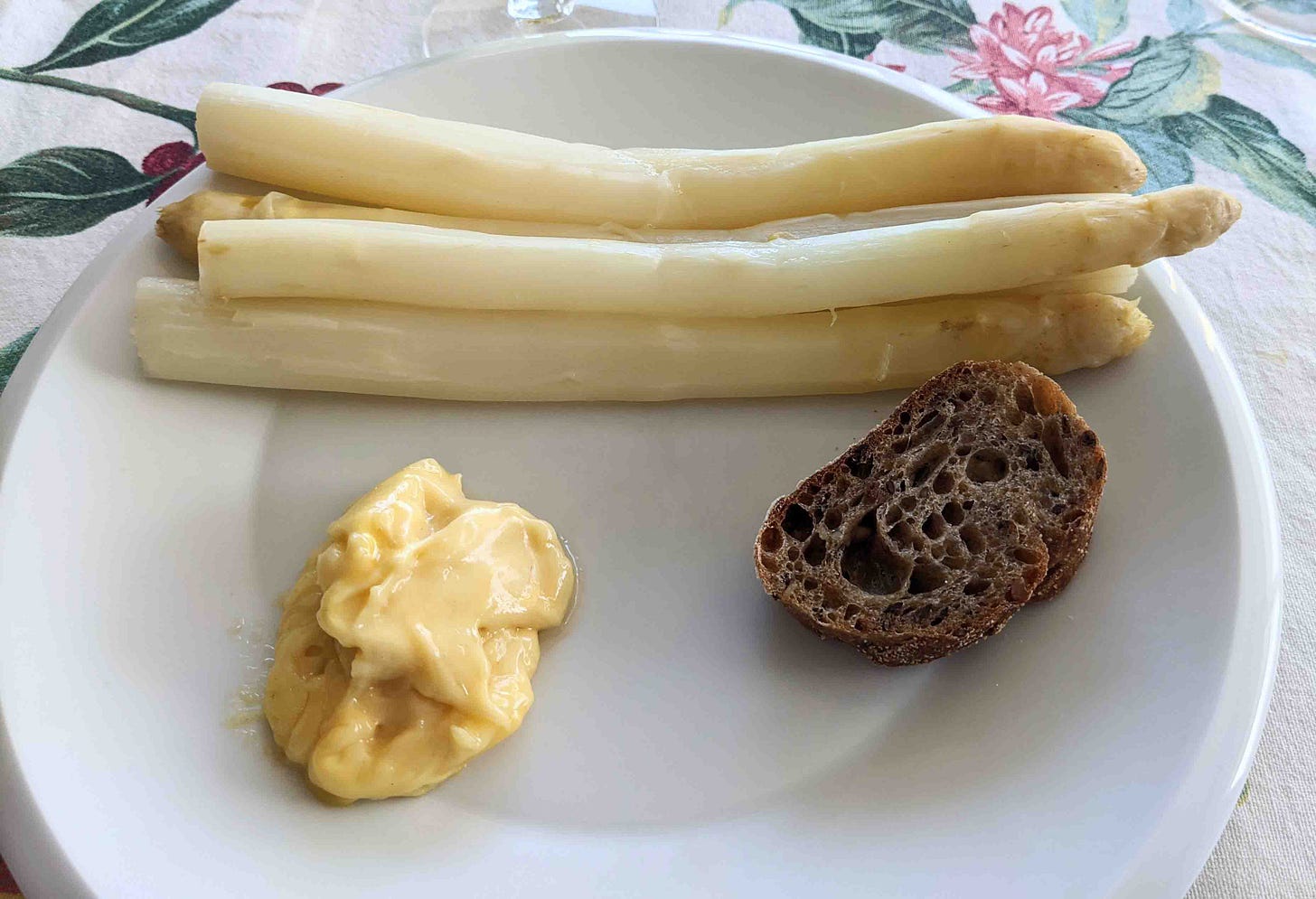

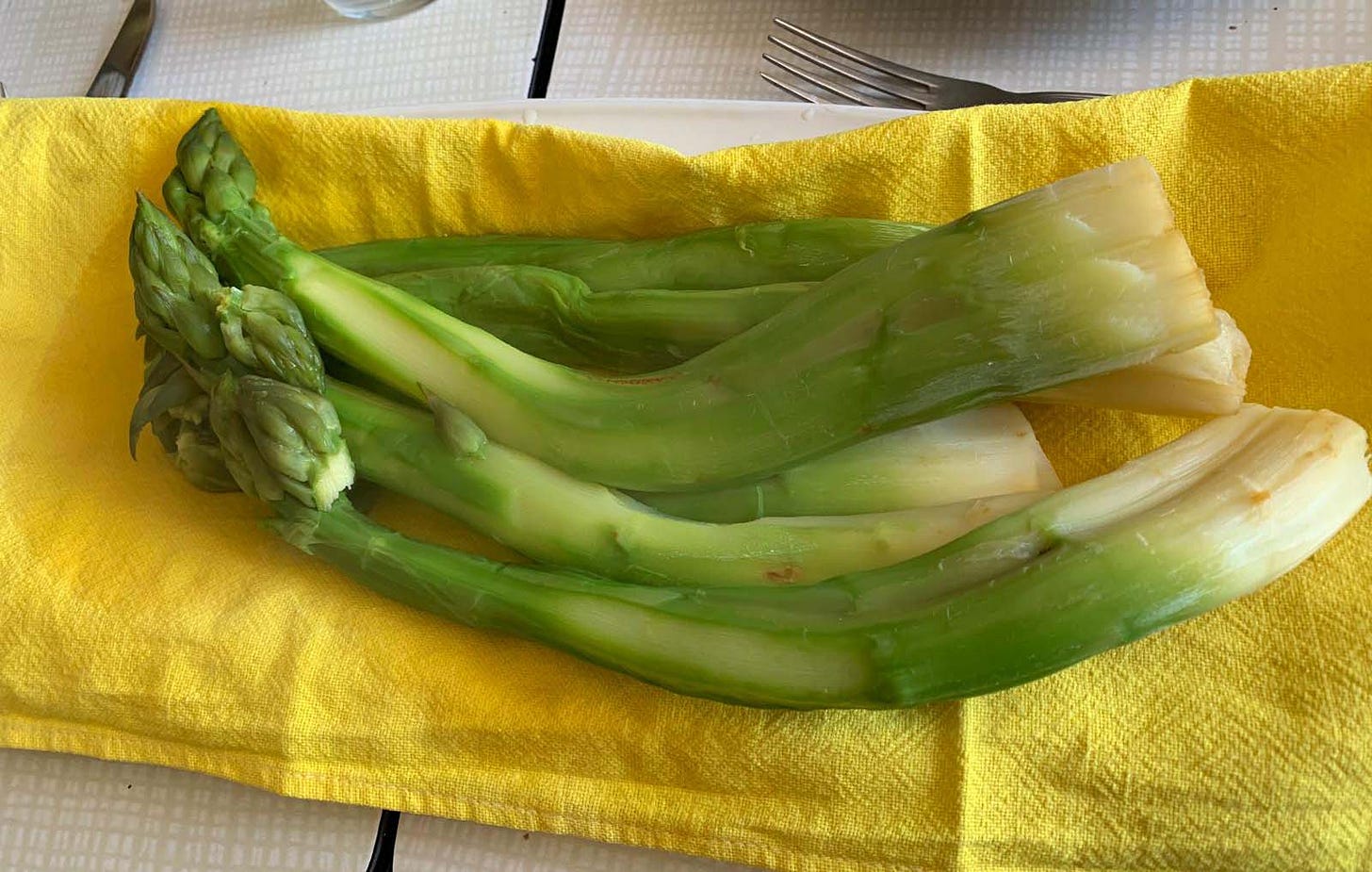
Our asparagus is just about ready to pick here in Spokane Wa. It is also my favorite vegetable. Loved your post!
I'm sorry your macrobiotic experience was so restrictive! I didn't find it till the early 2000s, but I understand that in the time you referred to it was much more rigid as you described. The focus on eating what is in season where you actually live (which is likely not Japan) is much more prominent now, and I enjoy asparagus regularly when it's in season here in Massachusetts (soon!) Would love to read the future post you mentioned about it!